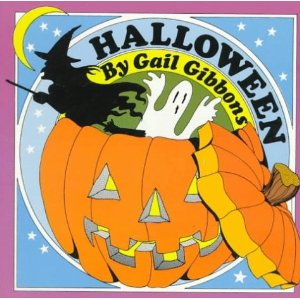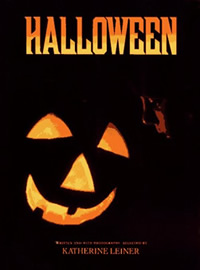What follows are short reviews of nonfiction children’s books with ‘Halloween’ in their title. Let’s see if we spot any trends.
 Halloween: Why We Celebrate It The Way We Do by Martin Hintz & Kate Hintz (1996)
Halloween: Why We Celebrate It The Way We Do by Martin Hintz & Kate Hintz (1996)
A plain, old boring pumpkin on the cover of this. It might as well be a pumpkin book. Or an autumn book. Or, heck, Thanksgiving. Seriously, they couldn’t even be bothered to carve the thing?
Page 8 starts ‘wear for Halloween’. What happened to the first part of the sentence? I scan back. The previous two pages are pictures of two kids in costume. The line before that on the previous page is apparently a caption for another photo. Or something. Maybe it’s a bullet point? ‘A simple Halloween costume can also be scary.’ It actually took me several moments to find the first half of the sentence. I’d already forgotten I’d read it and it trailed off. If this is confusing for me, how is a kid going to work it out?
“Winter was a confusing time for the Celts. They did not understand why it was so dark so much of the time.” o.O Way to make the Celts sound like idiots.
Oh, man, dude! Did you seriously just lie to the little kiddies? Chapter 3 talks about symbols of Halloween, one of which is witches, apparently. And it said that many women were burned as witches in Salem, Mass. Tsk! Research, people! You think you can just write a kid’s book about Halloween because you know everything, do you? Don’t have to look up squat, do you?
Well, this book tries to cover everything. How to celebrate it, the history of it, razorblades in chocolate, how to make a costume or a jack o’ lantern. I do like the pictures. Some are historical, some are photos from the 50s or 70s, some are color postcards. None of the children pictured in costumes is really in anything that looks professional and good. Homemade, or an off-the-rack cheap Transformer costume. I’m surprised the Transformer made it in there for trademark reasons!
I did not like the factual errors, and the presentation of theories as fact. I did not like the short, choppy sentences. And by the end, I was quite tired of hearing that Halloween is fun! Even when it’s scary and creepy and based on old religions. It’s fun! Remember, kids, it’s fun! Have fun!
 Halloween by Gail Gibbons (1984)
Halloween by Gail Gibbons (1984)
This book has one or two sentences on each page, beneath a picture. It’s a pretty good introduction to Halloween. Gives the date, what people sometimes do, a very little history. Covers costumes, jack o’ lanterns, trick-or-treating, parties, haunted houses, decorations, etc etc. A theme I see repeating already.. remember, kids, tricks are something people used to do. And don’t forget that Halloween is for fun! One criticism I have is the overuse of ‘some’ and ‘sometimes’. I only counted five uses, but there’s sort of.. implied ‘somes’ in other places. Like, ‘many’, or ‘people’, or ‘might’. It gives a very wishy-washy sort of feel to it. Like nobody can quite decide on how to celebrate Halloween. Even if it’s true.. it was a little excessive. At least I didn’t notice any factual errors in this one!
—
This post was going to be longer, but.. I can’t find any more nonfiction Halloween children’s books! I find a couple in verse in the folklore and literature nonfiction sections. And the rest are about Halloween crafts, Halloween food, Halloween costumes. Have I actually plumbed the depths of books explaining what Halloween is to children?
Actually, the problem I ran into was that the children’s room has a ‘Holiday Books’ category, which is fiction and nonfiction mixed together. And they have since cleared out the shelf of Halloween books to put them in various displays. So there may be more books, but they’re hiding on a display where I didn’t spot them, or they’ve been checked out.
Okay, one last book that I had on hold that came back. Though it’s classified at the library as fiction, it’s not.. well, it’s not a story. It’s not exactly nonfiction either though. But I shall include it.
—
 Halloween written and with photographs selected by Katherine Leiner (1993)
Halloween written and with photographs selected by Katherine Leiner (1993)
Dedication is to all children with AIDS. Then there’s acknowledgements thanking photographers and noting that the book is raising money for AIDS. Then there’s an Introduction about the author as a child being a gypsy on Halloween (not PC). And some notes about where the pictures came from. Some candid, some posed, some for this book, some from files.
Then a description of the Pediatric AIDS Foundation written by a 10 year old.
So by this time, I’m quite puzzled. Do the kids in the photos all have HIV/AIDS? What exactly is this book?
I’m not much enlightened as I flip the page. And flip it again. And again. Turns out these are all professional photos of people in costume, though I question that they’re all kids. And they’re not all for Halloween. And meanwhile Leiner has written some text. Some.. random text. That nominally has something to do with the photo. Though most of them are in the first person, as if she’s the person in the photo. Except the one she pegs as a magician, I think is a caballero. And the one she claims is a werewolf looks more like a fancy vampire to me.
The photos are cool. I mean, some of them are really cool. Even the cover of the book is pretty cool. (That’s a child’s face reflecting the glow of the pumpkin.) I… just… don’t get the text. Or the book as a whole.
—
All in all, rather a disappointing foray into the world of nonfiction children’s books about Halloween.


I was looking at all the Halloween books we had on display right now, but none of them looked very good.
I find myself drawn to Halloween books with witches prominantly featured. So few of those actually have Halloween in the title though.